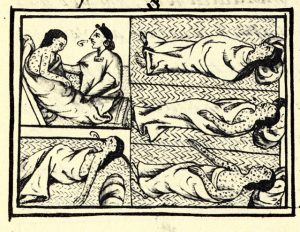
El intercambio colombino y el impacto en las poblaciones mundiales
El intercambio que ayuda a formar la agricultura moderna no solamente afecta las plantas y los animales. A la lista de organismos que van de una parte del mundo al otro tenemos que incluir a los seres humanos y los organismos infecciosos.
Cuando los europeos llegan a las Américas, encuentran a muchos grupos indígenas con sociedades y lenguas diferentes—los inuit, los algonquinos, los cheroqui, los aztecas, los taínos, los caribes, los incas, los guaraníes y más—unas 20 millones de personas.
¿Cómo es que un número pequeño de europeos puede conquistar a poblaciones indígenas tan numerosas? Una razón importante son las enfermedades europeas. La lista de enfermedades del Viejo Mundo que llega a las Américas es larga. Los efectos de la viruela, el sarampión, la gripe, la difteria, la malaria y la fiebre amarilla son catastróficos entre las poblaciones americanas, que no tienen ninguna inmunidad natural contra estas infecciones. Se calcula que hasta el 90% de los indígenas mueren de enfermedades europeas.
Muchos indígenas que sobreviven los masacres de los conquistadores y las enfermedades europeas tienen que hacer trabajos forzados para los europeos. Los europeos sacan productos agrícolas y metales como oro y plata de las Américas. En las zonas colonizadas por los españoles y portugueses, los indígenas están obligados a trabajar en las minas de oro y plata y en las plantaciones de tabaco, algodón, café y azúcar. Cuando no hay suficientes indígenas para trabajar, los colonizadores europeos comienzan a importar esclavos africanos.
Entre los siglos XVI y XIX, los europeos llevan aproximadamente 12,5 millones de africanos a las Américas como esclavos. UNESCO (Organización de las Naciones Unidas para la Educación, la Ciencia y la Cultura), en su reportaje, Struggles Against Slavery: International Year to Commemorate the Struggle Against Slavery and its Abolition, calcula que entre los africanos que sobreviven el transporte forzado, el 40% llegan a Brasil, el 40% al Caribe, el 10% al Cono sur y el 10% a América del Norte. Desde finales de siglo XVII a finales del siglo XVIII la esclavitud es abolida gradualmente y las colonias americanas forman países que son independientes de los países europeos.
Entender la materia
Organizar y compartir la materia
Create a pie chart that indicates the destinations of enslaved Africans who arrived in the Americas. Label it in Spanish and share it out loud with a classmate.
Investigación

Using what you’ve learned in the text and working in Spanish, create and populate a two-column table. Fill in the table with five diseases the Europeans brought to the Americas. Then research online to find out if there’s a commonly available vaccine for each one today. Here are your column titles: Enfermedad europea and ¿Existe una vacuna hoy?
Categorías
Using what you’ve learned in the text and working in Spanish, create and populate a two-column table with the raw materials and products the Spanish took from the Americas that fueled its economy in the era following Columbus’s arrival in the New World. Here are your column titles: Metales and Productos agrícolas.
Poblaciones
List the five countries in Latin America with the highest number of self-identified Afro-descendants and the five with the highest number of self-identified indigenous people. You’ll find data on these websites from the Pew Research Center and the Economic Commission of Latin American and Caribbean. Hint: The numbers at the Pew Research Center are given in thousands, so you’ll need to add .000 to each one. Be sure you can say the numbers in Spanish.
Sketch your own map or use an online site like amCharts to create a population map.
What map projection do you see when you go to amCharts? Think back to Unidad 1. What does that projection tell us about hegemony and colonization?
Your map should include:
- the countries in present-day Latin America with the highest number of Afro-descendants, all marked in a color of your choosing.
- the countries in present-day Latin America with the highest number of indigenous people, all marked in a different color of your choosing.
- Spain, marked with a third color.
- the present-day countries of Africa from which the majority of enslaved people originated (from Emory University’s website Voyages: The Trans-Atlantic Slave Trade Database), marked with a fourth color.
Discuss with with your classmate how European colonization and economic practices might have impacted the present-day distribution of the populations you mapped.
After completing this theme, I can …
- in Spanish, list two important human pathogens introduced to the Americas in the Columbian exchange.
- in Spanish, describe the impact of the introduction of Old World human pathogens on the indigenous populations of the Americas.
- in Spanish, list several agricultural products and raw materials that colonial Europeans sourced in the Americas.
- in Spanish, list the most frequent destinations of enslaved Africans in the Americas.
- in Spanish, describe the impact of colonial European economic practices on indigenous and enslaved peoples in the Americas.
- in Spanish, list the five countries in the Americas with the highest number of self-identified Afro-descendants and indigenous peoples and speculate on how history influenced the locations of those populations.
